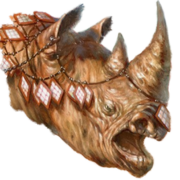Now that I got several drafts with them, I can say occasionals have worked quite well!
I've refined the concept further:
I am now
frontloading occasionals, so that the first booster has 2, the second booster has 1, and the third (and fourth+ if playing with more boosters) have 0. This is useful because several occasionals are meant to give direction to a deck, and are unlikely to be useful if seen late in the draft. Logistically, I made different packs for different rounds, but that was kind of a headache to mark them and make sure they didn't mix, so now I'm just making normal packs and giving people occasionals from a pile when they open the pack.
Some categories worked better than others. In particular, cards that give direction to a deck have been the ones that worked best:
Best occasionals
Single card archetypes: these add a lot of variety to the drafts and give decks identity for minimal space. I'mm very happy with these cards, though they are few and far between. Make sure they work with the cube's core. Remember the cube is still
mostly about the core, and without core support an occasional can't thrive.
Tri-color cards: giving an incentive to be in a particular tri-color combination gives a "secret goal" to the person who first picks a Siege Rhino to solve. The deck might feel almost like an EDH deck, with a headliner sponsoring it.
Good occasionals
Combat tricks: they work as well as intended, with two caveats: first, most tricks are balanced for retail limited and not actually that great even there, so I have to run the cream of the crop to be competitive. I ended up removing a lot, but I'm happy with the ones that got played. Second, part of the fun of combat tricks is deciding when to play around them. Although putting them in occasionals sounds like it make this more difficult, it's still doable if you've seen them during the draft, in a previous match, or in previous games. In fact, the occasional sticker sort of calls attention to them, so I feel like it's actually easier to remember the "combat trick of the day".
Finishers: having a variety of large creatures has kept them exciting to open, even when they aren't power level outliers.
Archetype intersections: as single card archetypes, these give direction to your draft and often are enough of a push to combine different archetypes for a unique deck. The issue with them is true ones are rare, and they are often misleading: cards that look like archetype intersections, are really of a single archetype. For example,
Abzan Falconer is a counters payoff, and not really a fliers card since flying is redundant when the creature has a counter.
Weird cards: these are fun and can give identity to decks too. This category is too broad to generalize, but it's just cool to see a couple of weird cards in the draft, while too many can feel overwhelming and Un-sety.
Silver bordered cards: I didn't mention these in my original article, but if you're always wanted to add a couple of silver bordered cards to your cube but didn't want it to be an "Un- cube", occasionals are a good way to sprinkle a few and not change the cube's identity.
Repetitive play patterns: Doing a lot of the same thing in one draft is fine and actually does give identity to a deck. But
Sprout Swarm is going too far, Anthony (
https://luckypaper.co/podcast/77/)
Mediocre occasionals
Cards removed to make space: some are still nice to see, but cards like generic removal spell don't really matter and I have been cutting them to make space for better occasionals.
Morphs: their identity needs a certain density to remain hidden so that a few need to be seen in a draft, and the power level of Grey Ogres is just too low even for my cube, unless the payoff is backbreaking like
Sagu Mauler. I decided to cut them though they was fun when they worked. Foretell would also fit this category.
I didn't actually find any categories of
bad occasionals, but I still don't recommend putting power level outliers in them and suspect they belong in this category.
Edit: Forgot to add the second point about combat tricks.


 at least it's an Occasional
at least it's an Occasional